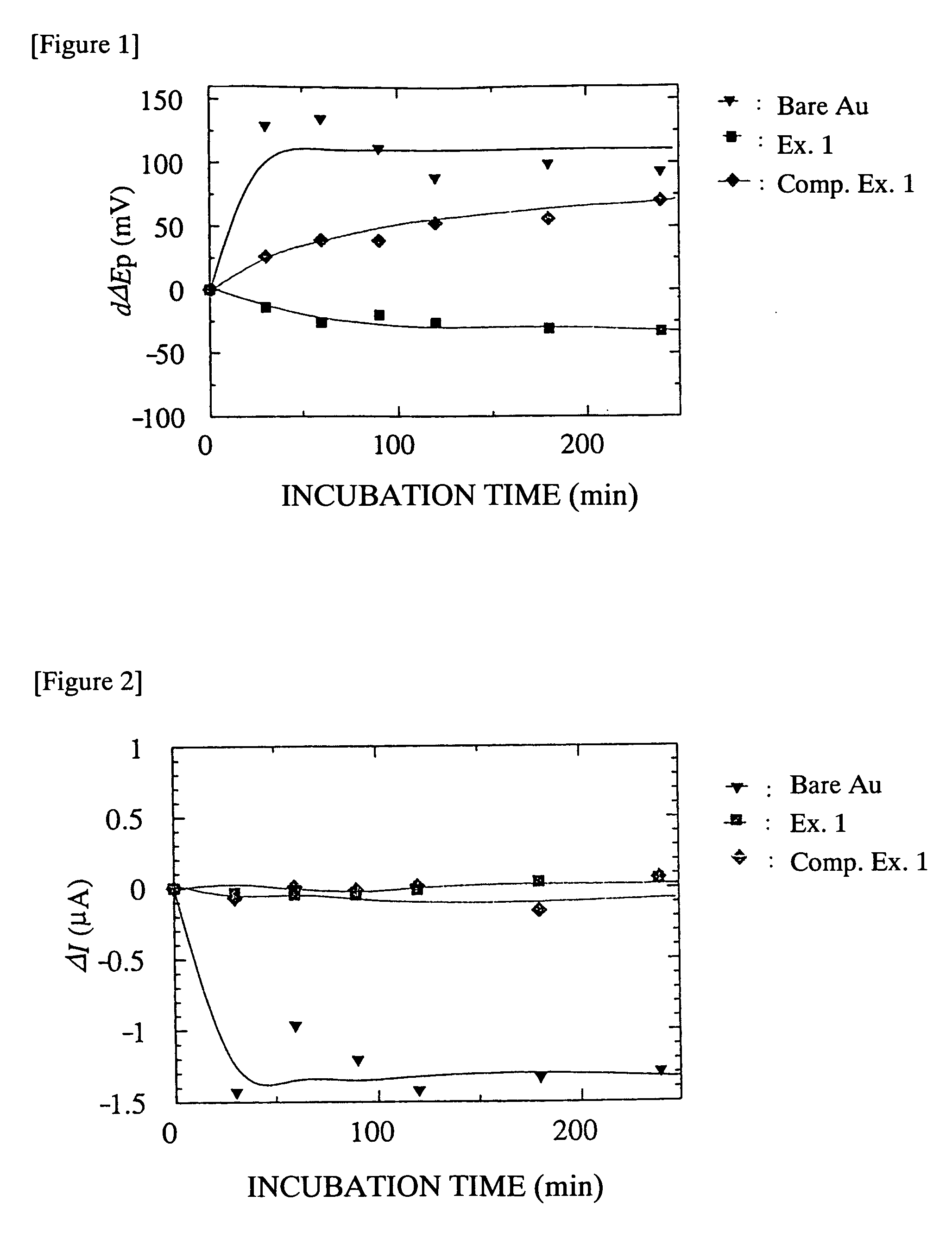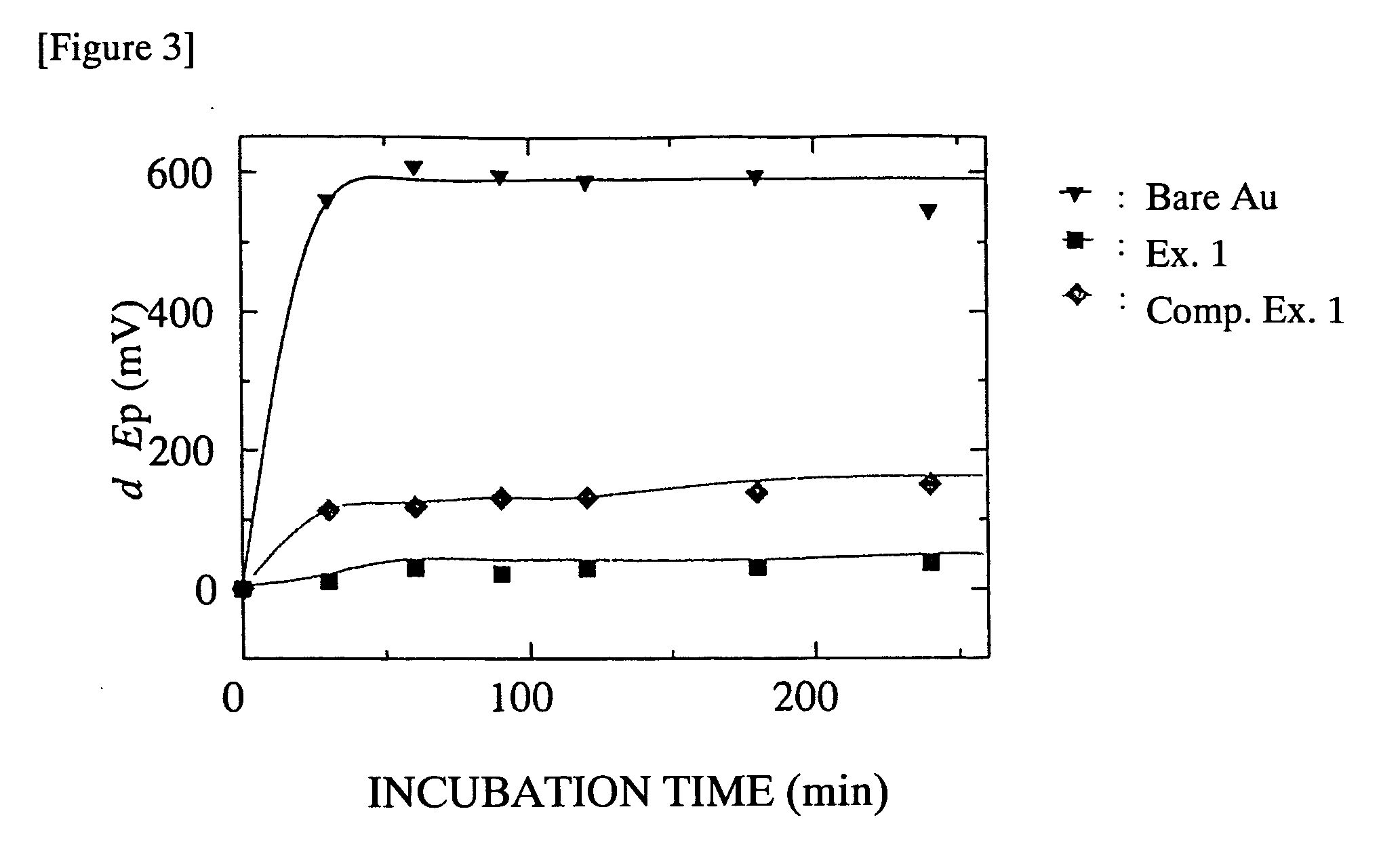Biocompatible Material
a biocompatible material and material technology, applied in the direction of dynamo-electric converter control, packaging foodstuffs, instruments, etc., can solve the problem of giving disadvantageous influence to biocompatibility, and achieve excellent biocompatibility
- Summary
- Abstract
- Description
- Claims
- Application Information
AI Technical Summary
Benefits of technology
Problems solved by technology
Method used
Image
Examples
example 1
[0041]The amount 11.9 mg of tetraethylthiuram disulfide was added as a photopolymerization initiator to a monomer composition composed of 234 mg of N-methacryloyloxyethyl-N,N-dimethylammonium-α-N-methylcarboxybetaine and 13.6 mg of bis[4-(N,N-diethyldithiocarbamoylmethyl)benzylamide ethyl sulfide]. Thereafter, the mixture was dissolved in a mixed solvent of 2.5 mL of methanol and 1 mL of tetrahydrofuran, and nitrogen gas was allowed to pass through the resulting solution for 15 minutes. Subsequently, the solution was irradiated with ultraviolet rays at a temperature of 25° C. in an nitrogen gas atmosphere for 4 hours, to subject the monomer composition to photopolymerization.
[0042]Next, the polymerized mixture was fractionated by ultrafiltration (fractionated molecular weights: 3,000 to 10,000), and the fraction was lyophilized to collect the formed polymer (yield: 45 mg). Degree of polymerization and weight-average molecular weight of the resulting polymer were examined by H1—NMR. ...
example 2
[0047]The same procedures as in Example 1 were carried out except for using 250 mg of a mixture of butyl methacrylate and N-methacryloyloxyethyl-N,N-dimethylammonium-α-N-methylcarboxybetaine [weight ratio of butyl methacrylate / N-methacryloyloxyethyl-N,N-dimethylammonium-α-N-methylcarboxybetaine: 4 / 6] as a monomer composition in Example 1, to give a polymer.
[0048]Next, the polymerized mixture was fractionated by ultrafiltration (fractionated molecular weights: 3,000 to 10,000), and the fraction was lyophilized to collect the formed polymer (yield: 50 mg). Weight-average molecular weight of the resulting polymer was examined by H1—NMR. As a result, the weight-average molecular weight was 18,000.
example 3
[0049]Twenty-five milliliters of methanol was added to 5.0 g of N-methacryloyloxyethyl-N,N-dimethylammonium-α-N-methylcarboxybetaine, and 70.8 mg of 2,2-azobisisobutyronitrile as a polymerization initiator and 0.15 mL of 2-mercaptoethanol as a chain transfer agent were added thereto, and the components were polymerized at 70° C. for 24 hours. Thereafter, the polymerized mixture was concentrated, and the concentrate was further dissolved in water. The solution was fractionated by dialysis (fractionated molecular weight: 1,000), and the fraction was lyophilized to collect the formed polymer (yield: 3.6 g). Weight-average molecular weight of the resulting polymer was examined by gel permeation chromatography (mobile phase: a 0.1 M aqueous sodium bromide containing 0.5% lithium bromide). As a result, the weight-average molecular weight was 11,400.
PUM
| Property | Measurement | Unit |
|---|---|---|
| polymerization time | aaaaa | aaaaa |
| polymerization time | aaaaa | aaaaa |
| temperature | aaaaa | aaaaa |
Abstract
Description
Claims
Application Information
 Login to View More
Login to View More - R&D
- Intellectual Property
- Life Sciences
- Materials
- Tech Scout
- Unparalleled Data Quality
- Higher Quality Content
- 60% Fewer Hallucinations
Browse by: Latest US Patents, China's latest patents, Technical Efficacy Thesaurus, Application Domain, Technology Topic, Popular Technical Reports.
© 2025 PatSnap. All rights reserved.Legal|Privacy policy|Modern Slavery Act Transparency Statement|Sitemap|About US| Contact US: help@patsnap.com



